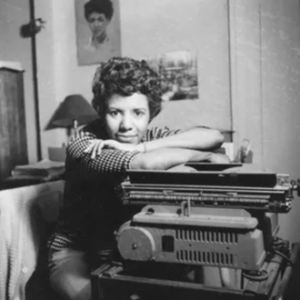Residence of Lorraine Hansberry Listed to National Register of Historic Places
20210519
By: BWW News Desk
Hansberry was also a dedicated activist for social justice, and she remains an important figure at the intersections of race, class, gender, and sexuality.
 The former residence of Black lesbian playwright and activist Lorraine Hansberry has been listed on the National Register of Historic Places, underscoring Hansberry’s incredible contributions to American arts and culture. Her play, A Raisin in the Sun (1959), was the first play by a Black woman to appear on Broadway. The Lorraine Hansberry Residence, at 337 Bleecker Street, in Greenwich Village, was first successfully nominated to the New York State Register of Historic Places by the NYC LGBT Historic Sites Project in March 2021, in collaboration with the New York State Historic Preservation Office. The historic site was officially listed to the National Register in April 2021.
The former residence of Black lesbian playwright and activist Lorraine Hansberry has been listed on the National Register of Historic Places, underscoring Hansberry’s incredible contributions to American arts and culture. Her play, A Raisin in the Sun (1959), was the first play by a Black woman to appear on Broadway. The Lorraine Hansberry Residence, at 337 Bleecker Street, in Greenwich Village, was first successfully nominated to the New York State Register of Historic Places by the NYC LGBT Historic Sites Project in March 2021, in collaboration with the New York State Historic Preservation Office. The historic site was officially listed to the National Register in April 2021.
While residing at 337 Bleecker Street, Hansberry lived parallel lives: one as a celebrated playwright and the other as a woman who privately explored her homosexuality through her writing, relationships, and social circle.
Amanda Davis, Project Manager, NYC LGBT Historic Sites Project: “Honoring the very place where Lorraine Hansberry lived and worked through these State and National Register listings marks another important step in our mission to highlight the contributions of LGBT people to American history. The site is also one of what we hope is a growing number of historic places nationwide that celebrates the achievements of Black women and lesbians of color. Hansberry’s active involvement in the civil rights movement and her influential writings on gender expectations and being a lesbian in 1950s America make her a thought-provoking figure for our time. The proximity of the Lorraine Hansberry Residence to Stonewall National Monument also provides an invaluable opportunity for tours and school groups to expand on their understanding of LGBT history beyond the 1969 Stonewall uprising.”
Erik Kulleseid, Commissioner of the NYS Office of Parks, Recreation and Historic Preservation: “For many students across the country, Lorraine Hansberry‘s A Raisin in the Sun is a first introduction to theater and playwriting. Not included in many of the curricula is the all too brief life of the author. The listing of Hansberry’s residence in the NYS and National Registers adds to the scholarship of her life as a gay author in the 1950s and 60s. Our partnership with the NYC LGBT Historic Sites Project continues to yield listings in the registers and solidifies New York’s leadership in the recognition of the lives and contributions of the LGBTQ+ community.”
From the National Register nomination, completed by the NYC LGBT Historic Sites Project:
The property at 337 Bleecker Street, in Greenwich Village, is nationally significant under Criterion B for its association with the pioneering Black lesbian playwright, writer, and activist Lorraine Hansberry (1930-1965). Hansberry resided in a third-floor apartment in the building from 1953 to 1960, the period of significance. During this time, she wrote her groundbreaking play A Raisin in the Sun in the apartment and, in 1957, first read it aloud there to her friend Philip Rose, who went on to produce it. In March 1959, Hansberry made history as the first Black woman to have a play staged on Broadway with Raisin’s premiere at the Ethel Barrymore Theater, in Manhattan. She became the first African American playwright, and the youngest playwright ever, to win the New York Drama Critics’ Circle Award for Best American Play.
An instant celebrity, Hansberry was photographed in her book-lined apartment on Bleecker Street for Vogue Magazine one month after the play’s premiere. A Raisin in the Sun, considered a classic, has become part of established literary canon and is taught in schools throughout the United States. The play is also still widely produced.
Hansberry was also a dedicated activist for social justice, and she remains an important figure at the intersections of race, class, gender, and sexuality. She worked alongside civil rights activists, such as her friends, writer James Baldwin and singer Nina Simone, and contributed to a variety of publications that focused on racial justice, communist, women’s equality, and LGBT causes in her lifetime. Many of these articles were written in her apartment at 337 Bleecker Street.
Even before the success of A Raisin in the Sun, Hansberry privately began to explore her lesbian identity; she found community in her small lesbian social circle in Greenwich Village and had at least two relationships with women who lived close by to her Bleecker Street apartment. While she was vocal about civil rights and other issues – speaking at an NAACP rally in Washington Square Park in 1959, for example – she remained private about her sexuality, choosing instead to participate in LGBT issues anonymously through her writing, both before and after she achieved fame for Raisin. She was among the earliest literary contributors to The Ladder (1956-1972), the national monthly magazine of the Daughters of Bilitis (DOB), the country’s first lesbian rights organization, founded in San Francisco in 1955.